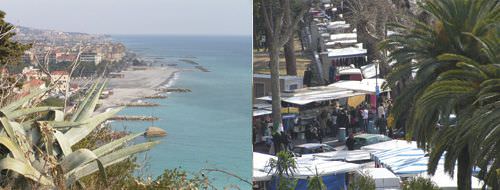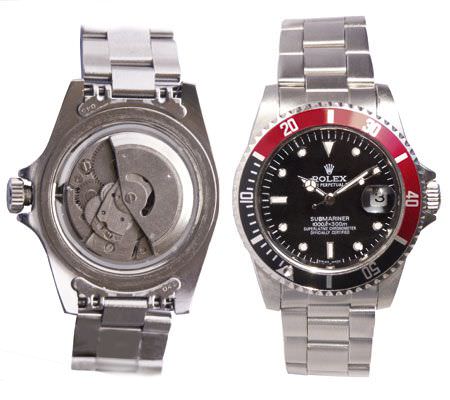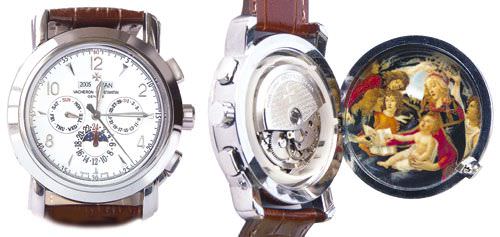
Ventimiglia is a typical Italian town on the Riviera dei Fiori. The name Ventimiglia has nothing whatsoever to do with the suggested ‘20 miles’, but derives from the Intermeli tribe that that once lived to the east of the modern town on the River Nervia. Abandoned in the 7th century, the population moved over the mountain above the River Roia and built a Medieval town as a protection against attack. Conquered by the Romans and called Albintimilium, it was later transformed into Ventimiglia.
Today, somewhat worse for wear, the old city remains on the hill overlooking the more modern town that began to develop at the beginning of the 19th century. The River Roia separates the old town and the new town. So ends the brief history lesson.
The Ventimiglia market
Ventimiglia has a very popular street market that runs parallel to the River Roia and the Mediterranean. Held every Friday, it has literally hundreds of legitimate traders with stalls selling everything from inexpensive socks to moderately priced leather goods. In between you can purchase pasta, umbrellas, salami, towels, kitchenware, cheese, travel goods, costume jewellery, clothes and ceramics. And, in addition to the authorized, fee-paying street traders, there are scores of unauthorized men (no women) offering fake watches, T-shirts, ladies’ handbags and sunglasses.
As you stroll through the market you are regularly asked if you want to buy a watch. These are discretely, and sometimes not so discretely, proffered by a man carrying a specially designed roll of cloth that contains a fair quantity of watches – with Rolex being by far the most popular brand.
Having decided with our Editor-in-Chief that we would prepare an article on the trading of fake watches, I made the short drive from Menton, the last town on the French Riviera, to the Ventimiglia market on the first Friday of the New Year.
With the car parked near the Old Town, I crossed the footbridge over the river and turned right into the alley of stalls and began casually browsing at the scarves and ties. Being January there were fewer visitors than in the summer months, nevertheless they were there in the hundreds rather than thousands. After about twenty metres I was accosted by the first watch ‘salesman’ and offered a Rolex Submariner (exhibit No. 1). Relatively short and of North African origin, he informed me that his best price for the timepiece was 200 euros. I looked at him with raised eyebrows and smiled. “OK,” he said, “150 euros.”
I asked his name and then said, “Forget it Omar, I’ll look elsewhere,” and started to move away. Grabbing me gently by the arm he then offered it for 100 euros. I politely refused and he suggested 50 euros.

Exhibit 1: Fake Rolex Submariner

Exhibit 2: Fake Vacheron Constantin Perpetual Calendar.
At that point I asked Omar where the watch was made. “It’s Italian. Good quality, from Napoli, not China,” he insisted. I took another look at the watch, and said that it was not very good quality. “OK. How much you wanna pay?” he asked. “Twenty euros,” I replied. “Thirty,” he countered. “Twenty-five,” I said, “and that’s my final offer.” He accepted the 25 euros.
All of this discussion and bartering took place in the midst of the passing crowd, with Omar constantly keeping an eye open for any trouble. Having paid the money and received the watch, Omar disappeared like the proverbial puff of smoke.
Rolex to Vacheron Constantin
A few metres further on, another man, possibly from the same country as Omar but head and shoulders taller, had two watches in his hand – both Rolexes. I said I already had a Rolex Submariner and asked if he had any other brands. He looked up and down the market and suggested we went into the park just a few metres away.
Feeling adventurous and with the interests of Europa Star at heart, I followed him. He stopped beside a fairly large wastepaper bin and produced a cloth roll from under his coat. He carefully spread it across the top of the bin to reveal around eighty or so different watches, including copies of a Rolex Daytona, an Audemars Piguet Royal Oak, Eberhard’s Chrono 4 with a black dial and a stainless steel bracelet, several Gucci and Chopard models and a whole host of other ladies’ watches. I pointed to a Vacheron Constantin model (Exhibit 2) and asked the price: 250 euros.
Unlike my previous encounter, the ‘salesman’ wouldn’t tell me his name, but in a mix of Italian, French and English I was made to understand that this watch was expensive because of its numerous features, one of which was a hinged caseback which opened up to reveal the automatic movement with Vacheron Constantin’s markings on the rotor and a copy of a classical painting pasted inside the cover. The dial had all the features of a perpetual calendar – year, month, day, date, second time zone and central seconds hand. There were four correctors, two pushbuttons at 2 and 4 o’clock and two inset buttons at 8 and 10 o’clock. The quality of the workmanship left much to be desired, so I questioned its origins suggesting that it looked as though it came from the Far East. Mr. X looked quite put out and insisted that it was made in Italy- “ees from Napoli!”
Naturally, I balked at the price and without further ado it dropped to 100 euros. I then explained that I really wasn’t interested and was asked again how much I wanted to pay. When I was finally offered the watch for 35 euros with a ladies’ ‘Rolex’ (Not shown) thrown in, I figured it was worth the purchase from the editorial viewpoint.
The ladies’ ‘Rolex’ had the Rolex brand name on the dial, however, the case and bracelet were far more reminiscent of an Ebel. It had a quartz movement and appeared to functioning more or less correctly.
Over the next hundred metres there were ‘watch salesmen’ every twenty metres or so, but I decided to keep moving, only stopping to watch a carabiniere, with one hand on his hat and the other on his gun holster chase someone – almost certainly a pickpocket since it is highly improbable they would work up a sweat on anyone selling fakes.
By then I had reached an area of the market where the stalls are aligned on both sides of a straight section of the market, with a long seaside promenade running parallel behind the stalls. It has some seafood restaurants and, at a very modest estimation, sixty different people all selling fake luxury goods. It is here that you find laid out on the ground for everyone to examine and purchase most of the Louis Vuitton and Dior handbags, Ralph Lauren shirts and various ‘branded’ sunglasses, T-shirts and belts. The items are carefully placed on a plain white sheet that can be whisked up into a bundle within seconds and thrown over the seller’s shoulder should one of the local police inadvertently stray into their domain.
It may sound a little sarcastic to use the phrase ‘inadvertently stray into their domain’, however it certainly appears to be the case. For fear of being castrated with a couple of building blocks, I didn’t use my camera, however, feigning to telephone someone on my portable ‘phone I managed to take two very poor quality photos (seen here for what they are worth) – one of a watch ‘salesman’ and the other one of two policemen and a policewoman standing just metres away from him doing absolutely nothing.
I recently read on a website concerning Ventimiglia the following text: ‘In June 2005 the authorities caught and fined several tourists buying fake goods - hitting them with a fine of 10,000 Euros (though reduced to 3,333 Euros if paid within a month). Of course, if they were serious about stopping counterfeit goods they could stamp it out in a single market day - and see the very rapid demise of the market. As it is, a few cases in the media shows something is being done and allows the sellers to continue on their favourite mid-week patches - directly opposite the police station and town hall! In July 2005 a bill was going through parliament to reduce the fines to 200 Euros.’
It is fairly clear that the Italian authorities have little or no intention of eliminating the market of fake luxury goods. Instead of imposing fines on the buyers, why not act against the sellers and manufacturers? As the website statement hints, the Italian authorities could easily stamp out the practice in one fell swoop. But they don’t and they won’t since it would mean fewer visitors and the local economy would obviously suffer ... not to mention the jobs involved in Naples where the majority of the Italian fake watches seem to originate.
So now for the fifty thousand dollar question: Are the Italian authorities as big a fake as the watches?
A professional opinion on the fake watches
In order to obtain a professional opinion of the watches and their movements, I fixed an appointment with Denis Asch, watchmaker and owner of L’Heure Asch watch boutique in Geneva’s Old Town.
“The form of the Rolex Submariner is quite well copied but the quality is very poor, although the bracelet is not bad and has genuine screws in the links, which is rare in a fake because they are expensive to produce,” Denis Asch affirms. “The watch is clearly not waterproof,” he says with a smile as he unscrews the caseback with his fingers, “and the automatic movement is held in place by a plastic ring, a feature that you normally find in the cheapest quartz watches.
Denis took his loupe and checked the movement. “The wheels aren’t oiled, although the date and hours do function. What is rather strange is that the dial has been stuck to the movement with a double-sided adhesive tape. This is really the cheapest of fakes, badly made and finished. The steel is of poor quality and when it comes into contact with the skin’s acids, will almost certainly rust within three months. In short, I think that bracelet is worth more than the watch and its movement.”
Denis then took the ‘Vacheron Constantin’ with its brown fake ‘croco’ strap. “Although it has a fairly complex movement, it doesn’t work because the balance-spring has become detached. The movement has fingerprints all over it and the year function only covers the years 2004 to 2015. The dial has stamped details and also appliqué numerals and indices. It’s really a bad copy.”
The origin of the movements of both watches was not clearly determinable, but Denis thought they could be Russian. He also noted that there were no ‘fake’ numbers or model names engraved on the watches – factors easy to copy – except for the inscriptions on the Rolex bracelet which correspond to reality.
Of the third watch, a ladies’ model with ‘Rolex Oyster Perpetual Day-Date’ printed on the dial, Denis said, “It doesn’t even resemble a Rolex it’s in the form of an Ebel. The movement is a basic ETA quartz, although I’m not sure of the provenance, possible the Far East, but obviously a genuine movement, there’s no point in making a fake one.”
Denis Asch’s final comment? “I’ve rarely seen anything as disgusting as the two automatic movements. In fact, the fakes are really poor quality!”
Source: February - March 2006 Issue




